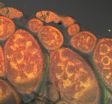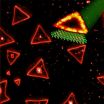(Press-News.org) PROVIDENCE, R.I. [Brown University] — Diseases from a mutation in one genome are complicated enough, but some illnesses arise from errant interactions between two genomes: the DNA in the nucleus and in the mitochondria. Scientists want to know more about how such genomic disconnects cause disease. In a step in that direction, scientists at Brown University and Indiana University have traced one such incompatibility in fruit flies down to the level of individual nucleotide mutations and describe how the genetic double whammy makes the flies sick.
"This has relevance to human disease but it's also relevant to all organisms because these two genomes are in all animals and all plants," said David Rand professor of biology at Brown and senior author of the study published online Jan. 31 in PLOS Genetics. "There are a lot of metabolic diseases that are mitochondrial in origin and they have peculiar genetic tracking — a two-part system needs to be considered."
Five years ago at Brown, Rand and two postdoctoral researchers — Colin Meiklejohn, of Brown and Indiana University, and Kristi Montooth, now an assistant professor at Indiana University — began searching for an example in the convenient testbed of fruit flies. They started mixing and matching mitochondrial and nuclear genomes from different strains and species of flies that carried natural mutations produced during evolution to observe what conflicts might arise. They found that when they placed the "simw 501" mitochondrial DNA from Drosophila simulans flies into Drosophila melanogaster flies with "Oregon R" nuclear DNA, bad things happened.
The flies with this combination lived but had an array of problems. Their most noticeable flaw was that whisker-like bristles on their backs were only half the length of those in normal flies. The flies also had developmental delays, reproduced less effectively, and tired more quickly, which makes sense because the mitochondria is the cell's power plant.
Once the team, including lead author Meiklejohn, had a bona fide mitochondrial-nuclear incompatibility to study, they could then begin looking for exactly where the problem lay and how it was causing disease. In the paper, they describe the genetic and biochemical experiments they conducted to find out.
Brown graduate student Marissa Holmbeck, the paper's second author, measured the productivity of several enzymes in the mitochondria's power generation process. Two enzymes that are derived entirely from nuclear genes ran just as well in the sick flies as in healthy ones, but three enzymes that are jointly managed by mitochondrial and nuclear genes lagged behind in activity.
"The different complexes that are jointly encoded by the mitochondrial and nuclear subunits, those are the ones where we are seeing the defect in activity," Holmbeck said.
Each mutation alone, in fact, does little or no harm to flies. It is only when both are present that the flies fall ill.
Meanwhile, Meiklejohn and Montooth tracked those mutations to just two altered nucleotide letters — one in each genome. In the mitochondrial genome, a G to U mutation in an RNA suggested a problem with protein production inside the mitochondria. This was confirmed when they discovered an A to V mutation in the nuclear protein that adds an amino acid to this same mitochondrial RNA.
The biochemical and genetic evidence pointed to flaws in how fast the mitochondria of the sick flies could produce proteins needed to promote growth.
"The specifics of this paper are tracking that down to the individual nucleotide," Rand said, "But the more general lesson is that this coevolution of mitochondrial and nuclear genes has been going on for millions of years in millions of organisms and is going on in human populations today."
In human beings, a well-known mitochondrial disease, for example, is an aversion to exercise that is due to a mutation in the same mitochondrial RNA gene the team studied in fruit flies.
Rand and his group are now conducting new experiments to trace more mito-nuclear incompatibilities within a single species to their genetic and biochemical roots.
"This paper provided proof of principle that we can identify these things and map them to their nucleotides," Rand said. "We want to ask how common is this and can we find other sources of this kind of breakdown in mito-nuclear crosstalk underlying disease."
INFORMATION:
In addition to Rand, Montooth, Meiklejohn, and Holmbeck, other authors on the paper are Dawn Abt of Brown and Mohammad Siddiq of Indiana.
The National Institutes of Health funded the research with several grants, including GM072399, F31AG040925, R01GM067862, R01AG027849, and GM076812. The National Science Foundation funded the research with grant DEB-0839348. Support also came from Indiana University.
Mitochondrial mutations: When the cell's 2 genomes collide
2013-02-05
ELSE PRESS RELEASES FROM THIS DATE:
Old age offers no protection from obesity's death grip
2013-02-05
Obesity kills, giving rise to a host of fatal diseases. This much is well known. But when it comes to seniors, a slew of prominent research has reported an "obesity paradox" that says, at age 65 and older, having an elevated BMI won't shorten your lifespan, and may even extend it. A new study takes another look at the numbers, finding the earlier research flawed. The paradox was a mirage: As obese Americans grow older, in fact, their risk of death climbs.
Ryan Masters, PhD, and Bruce Link, PhD, at Columbia University's Mailman School of Public Health, in collaboration ...
Giving transplanted cells a nanotech checkup
2013-02-05
Researchers at Johns Hopkins have devised a way to detect whether cells previously transplanted into a living animal are alive or dead, an innovation they say is likely to speed the development of cell replacement therapies for conditions such as liver failure and type 1 diabetes. As reported in the March issue of Nature Materials, the study used nanoscale pH sensors and magnetic resonance imaging (MRI) machines to tell if liver cells injected into mice survived over time.
"This technology has the potential to turn the human body into less of a black box and tell us if ...
Next-gen e-readers: Improved 'peacock' technology could lock in color for high-res displays
2013-02-05
ANN ARBOR—Iridescence, or sheen that shifts color depending on your viewing angle, is pretty in peacock feathers. But it's been a nuisance for engineers trying to mimic the birds' unique color mechanism to make high-resolution, reflective, color display screens.
Now, researchers at the University of Michigan have found a way to lock in so-called structural color, which is made with texture rather than chemicals. A paper on the work is published online in the current edition of the Nature journal Scientific Reports.
In a peacock's mother-of-pearl tail, precisely arranged ...
Samoan obesity epidemic starts at birth
2013-02-05
PROVIDENCE, R.I. [Brown University] — As some Pacific island cultures have "westernized" over the last several decades, among the changes has been a dramatic increase in obesity. Researchers don't understand all the reasons why, but even a decade ago in American Samoa 59 percent of men and 71 percent of women were obese. A new Brown University study finds that the Samoan epidemic of obesity may start with rapid weight gain in early infancy.
The implications of the study published online in the journal Pediatric Obesity may not be confined to Polynesian populations, said ...
Light-emitting triangles may have applications in optical technology
2013-02-05
For the first time, scientists have created single layers of a naturally occurring rare mineral called tungstenite, or WS2. The resulting sheet of stacked sulfur and tungsten atoms forms a honeycomb pattern of triangles that have been shown to have unusual light-emitting, or photoluminescent, properties. According to team leader Mauricio Terrones, a professor of physics and of materials science and engineering at Penn State, the triangular structures have potential applications in optical technology; for example, for use in light detectors and lasers. The results of the ...
Some omega-3 oils better than others for protection against liver disease
2013-02-05
CORVALLIS, Ore. – Research at Oregon State University has found that one particular omega-3 fatty acid has a powerful effect in preventing liver inflammation and fibrosis – common problems that are steadily rising along with the number of Americans who are overweight.
The American Liver Foundation has estimated that about 25 percent of the nation's population, and 75 percent of those who are obese, have nonalcoholic fatty liver disease. This early-stage health condition can sometimes progress to more serious, even fatal diseases, including nonalcoholic steatohepatitis, ...
Tendency to fear is strong political influence
2013-02-05
It's no secret that fear is a mechanism often used in political campaigns to steer public opinion on hot-button issues like immigration and war. But not everyone is equally predisposed to be influenced by such a strategy, according to new research by Rose McDermott, professor of political science, and colleagues published in the American Journal of Political Science.
By examining the different ways that fear manifests itself in individuals and its correlation to political attitudes, the researchers found that people who have a greater genetic liability to experience higher ...
Vitamin D, omega-3 may help clear amyloid plaques found in Alzheimer's
2013-02-05
A team of academic researchers has pinpointed how vitamin D3 and omega-3 fatty acids may enhance the immune system's ability to clear the brain of amyloid plaques, one of the hallmarks of Alzheimer's disease.
In a small pilot study published in the Feb. 5 issue of the Journal of Alzheimer's Disease, the scientists identified key genes and signaling networks regulated by vitamin D3 and the omega-3 fatty acid DHA (docosahexaenoic acid) that may help control inflammation and improve plaque clearance.
Previous laboratory work by the team helped clarify key mechanisms ...
JSCM publishes issue on NIDRR-funded project on practice-based evidence in SCI rehabilitation
2013-02-05
West Orange, NJ. February 4, 2013. The final phase of the SCIRehab Project (Phase 3) was published in the November 2012 issue of the Journal of Spinal Cord Medicine (JSCM). Nine papers comprised the Special Issue: Relationship of Inpatient Rehabilitation Interventions to Outcomes Following Spinal Cord Injury. Guest editors: J. Scott Richards, Gale Whiteneck, Daniel Lammertse, Marcel Dijkers, and Julie Gassaway. Key article available for free download via ingentaconnect.com: Whiteneck G, Gassaway J. The SCIRehab Project: What rehabilitation interventions are most strongly ...
Enigmatic 'ribbon' of energy discovered by NASA satellite explained
2013-02-05
DURHAM, N.H. -- After three years of puzzling over a striking "ribbon" of energy and particles discovered by NASA's Interstellar Boundary Explorer (IBEX) at the edge of our solar system, scientists may be on the verge of cracking the mystery.
In a paper published Feb. 4, 2013, in the Astrophysical Journal, researchers, including lead author Nathan Schwadron of the University of New Hampshire, propose a "retention theory" that for the first time explains all the key observations of this astrophysical enigma.
"If the theory is correct," Schwadron notes, "the ribbon can ...


